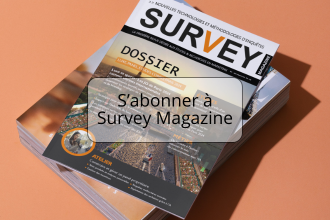We all receive many bad questionnaires to what we do not feel like answering or that we close after a few minutes. That is why we asked ourselves if it was really needed to give these 10 tips because they seemed so obvious for us and widely used. Of course, any similarity to other existing questionnaires or having existed is a simply coincidence.
Pay attention to the content, not to the time
10, 15, 20, 25 minutes! How many times do we have been upset because of too long questionnaires? How many times do we have stopped the questionnaire or ticked anything in order to get to the end?
Many surveys’ designers seem to fall into autism and are only interested in themselves and in their questionnaire rather than in people who has to answer. Unfortunately, it becomes today almost impossible to reason them because many designers are persuaded that the longer is the questionnaire, the better it is. Duration is not their issue.
But this is false. In order to manage a survey, we need to take the respondents into account. Respondents are not machines that give answers. The optimum duration of a questionnaire is the shortest (for us, maximum 10 minutes). Let us put ourselves in the respondents’ shoes et let us try to avoid them doing what we wouldn’t want to.
Ask all your question just in case
During the design of a questionnaire the temptation to put each question that we have in mind and related to the survey’s aims in is big. The need to forget nothing, to avoid missing interesting things, sometimes to grab the opportunity to highlight additional information.
But a good questionnaire must be short and only focused on the assigned aims to the survey. It will be easier to read it, easier to administrate it and easier to use than an ultra-complete and ultra-useless catchall.
Block your questions as mandatory
If your survey is well designed, each question must have a utility for you. In self-indicated surveys (usually web and mobile), you can be tempted to oblige respondents to give an answer to each question before going to the next one. But, you should accept that a question can be important to you but not to the respondent. When you oblige him/her to tick a case even if he/she does not want to, you depreciate your questionnaire by giving the feeling to the interviewed person to answer anything but clever. This often constitutes an abandon cause. That is why you should keep this mandatory status to only few essential questions to the survey (qualification questions, orientation question…).
Use a technical language
Usually, the survey’s instructor and designer are people specialized in their field. Their technicality can bring them to use specific terms or abbreviation to name products and concepts in their questions. But this is the best way to be misunderstood and get wrong responses. The first rule to have a good questionnaire is to avoid any jargon and to force ourselves to use clear and simple words, understandable to anybody. Write what your readers would easily understand without having to read the question once again. The best should be to use the usual daily language.
Range without deciding
We often offer range for digital question. The benefit is to facilitate the answer, especially when we talk about sensitive variables such as income or age. The mistake is to design wrong ranges following each other such as 18-25 years then 25-35 years then 35-45 years… A 25 or 35-year-old person won’t know where to tick.
Multiply open questions
Pretexting to let the respondent express him/herself and avoid letting essential elements disappear, many questionnaires have a lot of open questions (especially the HR questionnaires and those designed by beginners). But if open questions are essential in qualitative studies, they are almost useless in quantitative surveys. Conversely they make the survey longer, increase abandons, are rarely informed and when they are, the content is unusable. An open question at the end or in the middle of a questionnaire can be integrated. But more than one is too much.
Vague information
Many questionnaires have adverbs such as “often”, “sometimes”… Such adverbs are not understood in the same way by all respondents. Thus, a person who eats 4 days over 5 in a fast-food can tick that he/she eats there “often”. But a person who goes in this kind of restaurant once a week can also answer by “often”. One third person who was not used to eat in fast-food and who now eats there once or twice a month can also tick the same answer. In order to have precise answer, you must be precise in the frequencies formulation (ex: everyday or almost, once or twice a week…) and more usually all scales formulation.
Classify is classy
We may need to make people classify products, preferences… The rule in this case is to avoid offering too many answers to classify. Generally, it is difficult for us to classify more than three elements without wondering some things. For instance, I ask you to classify 5 colors (ex: orange, brown, purple, red and pink). The answer is not obvious and you risk giving two different classifications if you are asked this question twice. So we must limit classifications to a maximum of 3, 4 or 5 items (and not 10 or 12 as we sometimes can see).
Vary the scales
Evaluation scales are really useful to enable respondents to position themselves. Used in board, they help to shorten the questionnaire and to quicken the responses entry.
But in order to be effective, scales must stay homogeneous. So the advice to avoid disrupting the respondent and to enable him/her to give answer in the right scale is to avoid varying scales in a same questionnaire (ex: a 4 scale from “totally agree” to “totally disagree” and then another scale with notes from 0 to 10…)
Pay attention to the content, not to the style
Have you ever answered a questionnaire from a great institute and that seemed pleasant to you and well stylish? I don’t. We can wonder if more we design surveys, less we care about the appearance.
If you think (as Victor and me) that “Form is the essence brought to the surface”, then you should take care of your screens and give the fancy to answer to the respondent. It is easy to do it with adapted software provided that you care.












